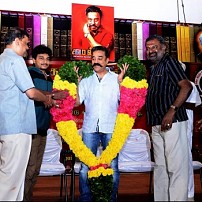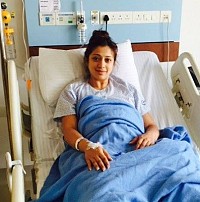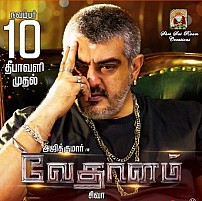SIVA AND I ARGUED FOR ABOUT TWO HOURS ON VEDALAM'S...
Interview Team : Jyothsna; Jeevakaran; Abishek Raaja; VenkatHere is a detailed interview with Audiographer Uday Kumar who talks about the mixing process for Ajith’s Vedalam, Visaaranai being a dream project and also the unknown nuances of sound engineering.
PHOTOS & STILLS - GALLERY
Sound of Nature is my favorite. I love travelling to the hill stations. We tend to avoid noise on the whole when we take a break from work. Since birth I was brought up here, the sound of the hills has no substitute. The sound of the air chipped by the trees is the most fascinating sound I’ve ever heard.
Hailing from a middle class family, I unlike my friends took up arts stream during college. Then through an advertisement in the newspaper, I came to know about film studies and that’s how I joined the course and completed in the year 1998 and then joined ‘Four frames’ as an apprentice. When it was a big deal to become the legend Deepan Chatterjee’s assistant, I had the golden opportunity to be his third hand and learn innumerable, countless stuff about sound designing. He was the one who mixed for Oomai Vizhigal. Just like Resul, he was the face of sound designers in the early 80’s.
Whatever you hear in the theatre, it is finalized by us.
Why do we still get to see the lip-sync issues when so much of work goes into all this?
The actual dialogue Ajith told was different from what he dubbed
When will we start shooting with sync-sound?
We need artists who can talk the language. Complete silence needs to be maintained on the sets. Lots of logistic complications need to be planned out. You basically need discipline and ethics to be able to do sync-sound.
Which technological advancement has made your work easy?
We had a tough time to get ambience sounds in those days but now we have sample bits for everything. I can just select the region and then copy it a million times. But years before, we used to record it in a quarter inch tape and then record till we wanted it. Software and equipments have definitely brought down the intensity of our work.
Visaaranai demanded the most from us
I loved Ruben’s brilliant work in Madras. I could feel the ambience.
Your hard work that went unnoticed, tell us about that.
In Naan Mahaan Alla climax, Yuvan sir had given us the music already. According to that tempo, we made the edits. Then there was a cut during the censor certification. The cut created a change that had to be mended to bring back the tempo. It took almost a day for us to settle it.
Authenticity in your work, please explain.
Why is Resul seen as a big phenomenon?
Deepan sir and Shridhar sir were the face of sound designers at some point. Only after the Oscars, people knew how sacred our work is. In films like Enthiran, Resul sir would ask for about 100 people to jump on a floor. All such needs and demands will not be meted out for others. Our work basically requires time and support from the directors. In Madras, we were waiting for a sound which was supposed to be given either by the sound designer or the music director. Till the end, nothing reached us. But later, Ranjith gave us the time to actually go record and use it later. Resul’s impact on our field has brought about a change in perception of our job description.
Our work basically requires time
Puli was an interesting film in my career.
Daas was my first un-credited film. Emtan Mahan was officially the first film. I have done about 200 films in Tamil, Telugu, Kannada, Malayalam and Hindi till date.
To elevate the scenes and match Ajith’s screen presence, we’ve done everything. From stunt sequences to adding reverb to the dialogues, Vedalam will be a ride all together.
I love my job and that is why I’m able to confine myself to a studio and work for days. I always want to associate myself with good projects and will want to know in what ways I can contribute to the product. But something that I have lost is, spending time with family. There has not been an occasion when I’ve been with them on time. My ticket will never be booked. I’m always a question mark when outings are planned. By the time I go home, everybody will be asleep.
That is the most saddening part of being an audiographer. Half the theatres lack the equipments and we can’t blame them. I went to a cinema hall to watch one of my works and I was shocked to realize one of the speakers not working. If the other speaker hasn’t worked, even the dialogues would have been audible. We spend so much time on panning and effects and this is the state of our work and we should be ready to deal with it. But at a subconscious level, we keep all kind of theatres in mind before bouncing the final track.
MAD MAX!!!
Projects you have worked so far.
FACEBOOK COMMENTS
OTHER LATEST TEXT INTERVIEWS
SOUND DESIGNER T. UDAY KUMAR RELATED NEWS
- Vedalam will have something out of the ordinary!
- Thala makes it a 'golden' Diwali for ...
- Vedalam is another Masss ...
- Can Vedalam cross Puli's count?
- Kamal and Ajith to back out?
- Vedalam does it for the first ever time!
- ''I felt guilty writing Visaaranai'' - Vetri Maaran
- Vetri Maaran's Visaaranai wows its first set of audience
- Can an 'angry' Ajith make it on time?
- Vedalam betters Puli!
- After 8 years, Ajith is at it again ...
- It's official: Vedalam release locked!
- Ajith's Vedalam passes an important test ...
- Vedalam, Billa and a few more for Thala ...
- Will Vedalam and Thoongavanam be the 4th?
SOUND DESIGNER T. UDAY KUMAR RELATED LINKS
- Kamal's Thoongaavanam Vs Ajith's Vedalam - Tamil Cinema This Week
- ''Ajith sir can tolerate such pain'' - A.M.Rathnam
- Ajith's Vedalam Expectation Meter
- Vijay59 first look; Pandavar Ani Wins! - Tamil Cinema This Week
- Vishal Vs Sarath Kumar ; Vedalam Track list - Tamil Cinema This Week
- Vedalam Music Review
- Vedalam Music Review
- Aaluma Doluma song teaser - Vedalam
- Vedalam Movie Teaser
- Idhu Namma Aalu | 10 EXPECTED FILMS OF 2015 - QUARTER 4 - Slideshow
- Idhu Namma Aalu I II III IV V VI VII VIII IX X XI
- Pasanga 2 | 10 EXPECTED FILMS OF 2015 - QUARTER 4 - Slideshow
- Pasanga 2 I II III IV
- Visaranai | 10 EXPECTED FILMS OF 2015 - QUARTER 4 - Slideshow
- Visaranai I II










